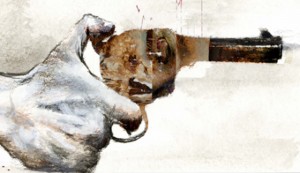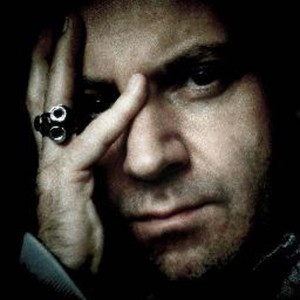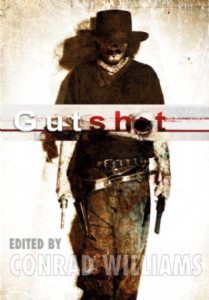(Conrad Williams, editor; 319 pages; PS Publishing, 2011)
The title says it all, though the first story (“Passage” by Alan Peter Ryan) seems to be a rather traditional, if a bit gory, Western. There is, I suppose, an underlying sense of the sinister and it could be interpreted as a tale of demon possession. Maybe that makes it more of a traditional Horror story featuring cowboys and Indians. James Lovegrove’s “The Black Rider” is more straight forward with its message… even if it does blur the line regarding what is considered “Western fare.” It is a fun read, though a bit obvious.
“The Alabaster Child” is a post-apocalyptic tale that hearkens back to Old West stories of gold rushes and prospectors and claim-jumpers. Just to mix things up a bit, Cat Sparks also tosses in an odd little sub-plot involving slave trade. While there’s really nothing overtly horrific about it, it definitely gets high creep-factor points from me.
“The Ghost Warriors” comes from the always fertile, generally warped mind of Michael Moorcock. Maybe the most well-known story here (by, certainly, the most well-known author featured), it was originally published in Moorcock’s 1997 collection, TALES FROM THE TEXAS WOODS. Most recently, it saw print in 2007’s THE METATEMPORAL DETECTIVE, a series of 11 stories starring Sir Seaton Begg, the dimension hopping head of the British Home Office’s Metatemporal Investigation Department (got all of that?), which fits quite well within the framework of Moorcock’s career-spanning “multiverse” (including, I’m certain, the Blue Oyster Cult songs “Black Blade,” of which a similar weapon plays an integral role here, and “Veteran of the Psychic Wars”). The story here reads like a standard masked hero Western, with the Masked Buckaroo (!) on the trail of a raiding party of Apache led by a supposedly long-dead Indian legend called Pale Wolf. This is the first tale in GUTSHOT to overtly feature any weird or supernatural overtones and is, as is generally the case with anything by Michael Moorcock, a great read.

Zander Shaw’s first published work, “Blue Norther,” is as fine a piece of Old West ghost story as I’ve seen. A tale of love, revenge, redemption and – ultimately – death. As Shaw says, “As a child, the most crushing thing that I learned was that everybody dies. That my parents would one day leave me affected me profoundly, more so than the impact of my own mortality. My mother and father died within ten months of each other in 2009. I wrote this story for my five-year-old self.” His five-year-old self must have been scared to close his eyes after reading “Blue Norther.” The next offering, “In the Sand Hills,” is a “geographic” Western by Thomas Tessier. Set in modern day Nebraska, it’s kinda like a “force of nature” horror story, though in the strictest Western sense of things, it’s about a hired gun sent out to bring back the ornery galoot that stole the payroll from his boss. The term “psychological thriller” comes to mind when reading this one.
If the last story was a “geographic” Western, then Stephen Volk’s “White Butterflies” is a “philosophic” Western. Staying in modern times, the scene changes from Nebraska to a setting that just screams “Western.” I’m speaking, of course, about Kazakhstan. The modern day fortune-hunters, seeking their wealth in the form of fallen rocket parts, is most assuredly the philosophic descendants of the dreamers who traveled to the American West in search of gold and riches. The claim-jumpers are more brutal but, like the Old West, Kazakhstan is a very brutal place for dreamers.

“El Camino de Rojo,” by Gary McMahon, is Clint Eastwood meets Stephen King at Satan’s desert resort. McMahon’s story feels and reads the most like a “true Western,” with its year long trek for vengeance, stopping along the way to bathe in the gore and blood… the kind that can only come from a truly dark and evil place. In a book of great stories, this one (to this point, anyway) is the centerpiece that binds them all. A masterpiece of short story telling.
A good portion of the stories in GUTSHOT seem to deal with those looking for an easy score or that big payday that’s just over the next rise. Such is the case with Joe R Lansdale’s “The Bones That Walk.” The twist here is that the protagonist of the piece knows that he’s already ruined his life for something that he wasn’t even sure ever existed. While, on the surface, Lansdale’s story appears to be the standard “hero buys a treasure map” type, it turns into something more. But that would be telling! Amanda Hemimgway comes as close to poetry as you’re likely to see in a collection like this with her piece, “Ghosts.” She says that, rather than writing a Western parody with gunslingers and vampires, she ended up “ …writing a pocket history of the West from the viewpoint of all its ghosts… “ Works for me.
Christopher Fowler’s “The Boy Thug” is, in Fowler’s own words, “an odd one.” It takes the idea of outlaw gangs to its base level, introduces a psychological angle and a cute kid to the mix, and stuns you with the ending. Fowler says that while he was having problems with the tone of his tale, he visited Northern India. “By melding the two attitudes (Wild West and the Indian frontier), the story came in one clear run without a single word change,and was one of my most satisfying writing experiences.” Likewise, it has been one of my most satisfying reading experiences. “Kiss the Wolf,” from Simon Bestwick, is another modern day yarn. A story of apocalyptic proportions, with dark riders, cannibals, witches (well, one, anyway) and… but, you should read for yourself. I don’t want to spoil the fun!
Mark Morris gets all psychological and philosophical (and maybe even a bit metaphysical) with “Waiting For the Bullet,” a story of four adventure seeking Brits in the wild and wooly United States. The story unfolds as a cross between WESTWORLD (although no robot Yul Brynners are involved) and a rock festival with a little temporal disturbance tossed in, as well. The moral of the story is, basically, the old war-time maxim of “You can’t dodge a bullet with your name on it.” Paul Meloy explores the Lakota Indian legend of the mischievous imp Iktomi and his cunning adversary, Coyote, in “Carrion Cowboy.” The story has the feel and flow of one told by the tribal elders to the youngsters as they sit around the fire, which is part of its charm and why it works better than it would in a standard Anglo writing style. SPOILER ALERT: There’s a part of the story that is strictly horror movie fare, as it explains why zombies (and other dead things) prefer the taste of flesh.
“Some Kind of Light Shines From Your Face” is part Greek mythology, part Oklahoma dustbowl and Hoover shantytowns and part women’s empowerment. Gemma Files’ tale reminds us that the old gods never truly die and that legends can be true. Peter Crowther (publisher and editor of PS Publishing) and Rio Youers are a formidable tag team on the excellent “Splinters,” a story of love and loss, life and death, faith and resurrection and the healing powers of music on the tortured soul. Oh, yeah… there are zombies and a shoot-out, too. Really, though,“Splinters” is, when all is said and done, a magnificent love story.

“All Our Hearts Are Ghosts” continues the sentimental vein, as Peter Atkins delivers another tale of love lost and revenge taken. Set in 1934 Los Angeles, the story is not so far removed, chronologically, from what we’ve come to know as the “Wild West.” It’s a story that offers the type of poetic justice thing that the movie industry loves. So, of course, that means that there’s a shoot-out on a dusty Main Street of a long-dead ghost town.
Sarah Langan’s “Beasts of Burden” is like an Old West version of THE OMEN… well, sort of. The child of Satan is orphaned and taken in by a farrier, a man with seemingly magical powers when it comes to caring for a horse’s feet and… soul. As the child grows, he learns the craft but is haunted by the voice of his father and the lost souls of men, women and horses. He also learns that the word “horse” has more than one meaning, especially to one such as his dear old dad.
“What God Hath Wrought” is an historical piece, but only in the sense that it is set in Utah and centers around the Mormon Church (kinda). Adam Nevill uses certain points in the history of that church to move his story to its ultimate conclusion. The starting point is their exodus from Illinois in 1846 and ends at the “Great Dead Sea” in Utah, two years later. As it turns out, the Church is mere periphery to the actual focal point, a vampiric shaman called Prophet Lehi. Another great story of revenge in the Old West. Finally, we have Joel Lane’s“Those Who Remember.” Set in modern (or slightly future) times, it’s a ghost story with, again, revenge as its basis. Unfortunately, the tale falls flat for me; the premise too shaky to be very engaging. Not a great way to end this collection, but in the grand scheme of things, we’re talking about one mediocre story out of 20… that ain’t bad at all!

Conrad Williams, the editor of GUTSHOT, has taken an odd angle that allows the authors of these tales as much latitude as possible with a genre that is due for a grand revival. I’m not saying that this book is the salvation of Western fiction, but it sure won’t hurt the future of the genre.

